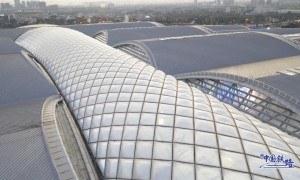《Technological developments of Japanese prefabricated housing in an early stage》
《早期日本装配式房屋的技术发展》
The Japanese version of this paper was published in Volume 78, Number 693, pages 2307‐2313 of the Journal of Architecture and Planning (Transactions of AIJ). The authors have obtained permission for the secondary publication of the English version in another journal from the Editor of the Journal of Architecture and Planning (Transactions of AIJ). This paper is based on the translation of the Japanese version, with some slight modifications.
本文的日文版发表在《建筑与规划学报》(AIJ会刊)78卷693号2307‐2313页。作者已经获得了《建筑与规划学报》(AIJ会刊)编辑的许可,可以在另一份期刊上再次发表英文版。本文以日文翻译为基础,稍作修改。
Abstract
摘要
Major prefabricated housing manufacturers started their business in the 1960s and became world‐class large housing companies. This study clarifies the early stages of development in 9 major prefabricated housing manufacturers based on interviews with their in‐house engineers and architectural designers as well as through the analysis of related documents. Early prefabricated houses were developed intensively by a small number of engineers. Various architectural styles and specialists, including foreign architecture, famous architects and academics, affected some aspects of these developments. Furthermore, each of the early prefabricated houses had many unique building system characteristics. Some of these characteristics were modified in the early stages of development, while others still remain today.
主要的预制房屋制造商在20世纪60年代开始他们的业务,成为世界级的大型房屋公司。本研究通过对9家主要的预制装配式房屋制造商的内部工程师和建筑设计师的访谈,并通过相关文件的分析,阐明了其早期发展阶段。早期的预制房屋是由少数工程师集中开发的。各种建筑风格和专家,包括外国建筑、著名建筑师和学者,影响了这些发展的某些方面。此外,每个早期的预制房屋都有许多独特的建筑系统特征。其中一些特征在发展的早期阶段得到了修正,而另一些特征至今仍然存在。
1 Introduction
1 介绍
1.1 Background and purpose
1.1 研究背景与目的
Japanese prefabricated housing manufacturers are unlike any others in the world; they were founded a half century ago, and now supply over ten thousand houses a year. They developed unique building systems between the end of 1950s and early 1960s despite the fact that there was no existing precedent for this type of housing in the Japanese housing market; their building systems have continued to grow until this day. Each company’s history does not adequately describe the early developments of building systems because the company’s history was not always focused on these developments, although some company histories may partially deal with them. Furthermore, investigating the details of the early developments through interviews with engineers who were in charge of them will become even more difficult in the future.
日本预制房屋制造商与众不同;他们是半个世纪前建立的,现在每年供应一万多套房子。他们在20世纪50年代末到60年代初开发了独特的建筑系统,尽管在日本的房地产市场上没有这种类型的住宅的先例;他们的建筑系统一直在发展,直到今天。每个公司的历史并不能充分地描述建筑系统的早期发展,因为公司的历史并不总是集中在这些发展上,尽管一些公司的历史可能会部分地处理它们。此外,通过对负责早期开发的工程师的采访来调查早期开发的细节在将来会变得更加困难。
In this circumstance, this study aims to clarify how Japanese prefabricated housing manufacturers developed their housing products in the early stages of the housing business and what the benefits of their approaches were. To verify these points, we extensively interview the engineers in charge of the early developments and examine their company histories, the drawings of early developments, and the existing housing examples.
在这种情况下,本研究的目的是澄清日本预制房屋制造商如何发展他们的住房产品在住房业务的早期阶段,以及他们的方法的好处是什么。为了验证这些观点,我们广泛地采访了负责早期开发的工程师,并研究了他们的公司历史、早期开发的图纸和现有的住宅实例。
1.2 Survey targets
1.2调查的目标
The survey targets of this study are 9 major prefabricated housing manufacturers in Japan. Table 1 shows their names and early housing products. In this study, we refer to the period of developing and selling these housing products as the early stage of the housing business for each manufacturer.
本研究的调查对象为日本9家主要的预制房屋制造商。表1显示了它们的名称和早期住房产品。在本研究中,我们将每个制造商开发和销售这些住房产品的时期称为住房业务的早期阶段。
| Structure | Company name (former name) | Early product (sale starting year) |
|---|---|---|
| Steel frame construction |
Daiwa House Industry Company 大和房业公司 |
Midget House (1959) 小型的房子(1959) Daiwa House Type‐A (1962) 大和房型‐A (1962) |
| Steel frame construction |
Sekisui House (Sekisui Chemical Company) 积水 |
Sekisui House Model A (1960) Sekisui House Model B (1961) |
| Timber panel construction | Eidai Company | Eidai House Type‐One (1960) |
| Steel frame construction | PanaHome Corporation (National House industrial Company split off from Matsushita Electric Works Company) 松下电器株式会社 (从松下电器株式会社拆分出来的国民住宅工业公司) |
Matsushita Type‐One (1961) |
| Timber panel construction | Misawa Homes Company (Misawa Wood Company) 三泽住宅公司(三泽木业公司) |
Misawa Home Free Size (1962) |
| Timber panel construction | S x L (Kobori Jyuken Company) | Kobori New Home (1968) |
| Steel frame construction | Asahi Chemical Industry Company 朝日化学工业公司 |
D Series (1970) |
| Steel frame construction | Sekisui Chemical Company 积水 |
Sekisui Heim M1 (1970) |
| Steel frame construction | Toyota Home Company (Toyota Motor Company) 丰田汽车公司 |
Office & Shop (1975) Type‐JA (1977) |
1.3 Methods
1.3 方法
This study uses the document research and interview methods. The former extracts evidence of the early developments of the 9 major prefabricated housing manufacturers from each company’s history, the company’s brochures of early housing products and the issues of a housing industry magazine published in the 1970s. The latter is carried out with engineers in charge of the early developments, except for the engineers of two manufacturers, Eidai Company and SxL.
本研究采用文献研究法和访谈法。前者从每家公司的历史、该公司早期住房产品的小册子以及上世纪70年代出版的一本住房行业杂志中,提取了9家主要预制房屋制造商早期发展的证据。后者是与负责早期开发的工程师一起进行的,除了Eidai公司和S x L两家制造商的工程师。
2 Preceding studies and context of this study
2 本研究的研究背景
Fundamentally, the company histories and founder’s biographies of major prefabricated housing manufacturers refer to the developments in the early stages of their operations in the housing business. However, these histories and biographies do not focus on the building systems and the personal ideas and experiences of the engineers in charge of their early developments, who played an important role in developing the early building systems through working as part of a small team in a short timeframe. Nevertheless, there are 3 important preceding studies related to this study. A representative study of building systems developed by Japanese prefabricated housing manufacturers from the 1960s to 1970s is included in the AIJ (Architectural Institute of Japan)’s book.1 This book explains the progress of prefabricated houses in Japan and illustrates details of representative building systems. On the other hand, Togo’s and Matsumura’s studies examine the emergence of the prefabricated housing industry in Japan and the technical differences in the early building systems through a review of changes in Japanese prefabricated houses.
基本上,主要预制房屋制造商的公司历史和创始人传记指的是他们在房屋业务早期阶段的发展。然而,这些历史和传记并不关注建筑系统,也不关注负责早期开发的工程师的个人想法和经验,这些工程师通过在短时间内作为一个小团队的一部分工作,在开发早期建筑系统方面发挥了重要作用。然而,与本研究相关的重要前期研究有3项。日本预制房屋制造商在20世纪60年代到70年代开发的建筑系统的代表性研究被收录在AIJ(日本建筑学会)的书中。这本书解释了预制房屋在日本的发展,并举例说明了具有代表性的建筑系统的细节。另一方面,多哥和松村的研究通过回顾日本预制房屋的变化,考察了日本预制房屋行业的出现以及早期建筑系统的技术差异。
3 Features of early development
3 早期发展特征
3.1 Background of development
3.1 发展背景
3.1.1 Specialized field of umbrella companies
3.1.1 母公司的专业领域
The 9 companies had their own various backgrounds in the development of prefabricated housing systems.
这9家公司在预制房屋系统的开发方面有各自不同的背景。
The variety of backgrounds of the 9 companies that started the development of prefabricated houses can be seen particularly in (i) the specialized field of their umbrella companies and (ii) in the companies’ usage of the umbrella companies’ technique .
开始开发预制房屋的9家公司的背景各不相同,这在以下两个方面表现得尤为明显:(1)他们的母公司的专业领域;(2)他们对母公司技术的使用;
Misawa Homes Company, Eidai Company, SxL and Daiwa House Industry Company are the companies whose umbrella companies were related to the architectural field: the predecessor of the Misawa Homes Company was a timber distribution company; the Eidai Company specialized in the manufacturing of wooden building materials; SxL’s predecessor was engaged in the design and construction of wooden houses; and the Daiwa House Industry Company was engaged in supplying temporary buildings constructed of steel pipes. They started to develop prefabricated houses in response to the growing demand for housing at that time. Among these four companies, Misawa, Eidai and SxL adopted wooden paneled building construction systems.
三泽住宅公司、Eidai公司、SxL公司和大和房业公司的母公司都与建筑领域有关:三泽住宅公司的前身是一家木材分销公司;爱德公司专业生产木质建筑材料;SxL的前身是从事木结构房屋的设计和建造;大和房业公司则提供由钢管建造的临时建筑。他们开始开发预制房屋,以应对当时不断增长的住房需求。在这四家公司中,三泽、Eidai和SxL采用了木质镶板建筑施工系统。
The remaining 5 companies were from large industries or a non‐architectural field, such as the chemical, electrical products, and automobile 4 industries.
剩下的5家公司来自大型工业或非建筑领域,如化学、电气产品和汽车行业。
3.1.2 Usage of the umbrella company’s technique
3.1.2 母公司技术的使用
Among the 5 companies, Sekisui House and Asahi Chemical Industry Company tried to divert new materials developed in a non‐architectural field into housing construction. Sekisui Chemical Company started to develop prefabricated houses with the aim of developing new applications of plastic material products, and Asahi Chemical Industry Company developed prefabricated houses in the process of trying to find usage for “Silikalitsit,” an ALC (Autoclaved Lightweight Concrete) panel introduced from the Soviet Union .
在这5家公司中,Sekisui House和旭硝子化学工业公司试图将非建筑领域开发的新材料转移到住房建设领域。Sekisui化学公司开始开发活动房屋,目的是开发新应用程序的塑料材料产品,和朝日化学工业公司开发活动房屋的过程中试图寻找“Silikalitsit”,一种(热压处理过的轻质混凝土)从苏联引进的ALC板。
As mentioned below, these two companies abandoned their efforts to apply the new materials, such as plastic and Silikalitsit, to structural uses and finally attached them as much as possible to steel structures.
正如下面所提到的,这两家公司放弃了将塑料和Silikalitsit等新材料应用于结构用途的努力,最终将它们尽可能多地应用于钢结构。
Meanwhile, Toyota Motor Company and Matsushita Electric Works Company began the development of prefabricated houses in order to seek new fields in which to apply their existing products and technologies. According to the documents of Toyota Home Company, Toyota was very serious about finding applications for their automobile technologies, and the application development was conducted jointly with their associated enterprises, such as Aisin Seiki and Nippondenso, who contributed their own expertise (Figure 1). Additionally, in the case of the National House Industrial Company, their intention of applying their existing products can be recognized in the testimony stating that “The aim is to develop and commoditize ideal houses with great habitability by utilizing equipment and building material products comprehensively,” while also stating “We shouldn’t apply plastic materials too much nor persist in our past products” and “Human habits and preferences must not be ignored.”
与此同时,丰田汽车公司和松下电器公司开始开发预制房屋,以寻找新的领域来应用他们现有的产品和技术。根据文档的丰田公司,丰田非常认真寻找应用程序的汽车技术,以及应用程序开发其与关联企业之间进行联合,如Aisin Seiki Nippondenso,贡献自己的专业知识(图1)。此外,在全国工业企业,打算运用他们现有产品可以被识别的证词陈述的目的是开发和商品化的理想房子的适居性综合利用设备和建筑材料产品,同时也说我们不应该使用塑料材料太多,也不坚持我们过去的产品和人类的习惯和偏好不能被忽略。
The development plan of Toyota Home in the early days. (The document “The Agenda of Toyota Home” from Toyota Home (in the interview on December 21, 2011) shows that the companies that joined the development of prefabricated houses by Toyota Motor Company were Nippondenso, Aishin Seiki, Kanto Auto Works, Toyota Forms, Toyota Boshoku, and Toyota Motor Sales. Figure 1 shows that the pilot house was divided into several parts and that each company developed their own parts, such as the kitchen developed by Nippondenso and the Japanese room and closet MAC (Movable Assembled Component) developed by Toyota Forms. The word MAC means closet of functions, an original word used by the Toyota Home Company.)
丰田Home前期的开发计划。(2011年12月21日接受采访的《丰田之家议程》文件显示,参与丰田汽车公司预制房屋开发的公司有日本电装株式会社、爱新精工株式会社、关东汽车厂株式会社、丰田表格株式会社、丰田博正库株式会社、丰田汽车销售株式会社等。)图1显示了试验住宅被划分为几个部分,每个公司都开发了自己的部件,例如由Nippondenso开发的厨房和由Toyota Forms开发的日式房间和壁橱MAC(可移动组装组件)。MAC这个词的意思是“功能壁橱”(closet of functions),这是丰田家居公司(Toyota Home Company)最初使用的一个词。)
3.2 Influence from other cases and persons
3.2 其他案件和人员的影响
Prefabricated houses in the early days were developed with few reference structures. Under this situation, prefabricated housing development was influenced by precedent cases published in documents, by architects and by research conducted outside the company.
在早期,预制房屋的发展几乎没有参考结构。在这种情况下,预制房屋的开发受到文件中公布的先例、建筑师和公司外部进行的研究的影响。
3.2.1 Idea from documents and other works
3.2.1 文献及其他作品的构思
Sekisui House Model A was a typical case in which the idea for the home was obtained from documents. The development of Sekisui House was started based on inspiration from an article about an all‐plastic house from the Monsanto Company. Additionally, a person in charge of the Model A development remembered that he used the frame of the Occupation Army housing (Quonset hut) as a reference when the decision was made to change the structural material from plastic to steel. Moreover, the engineer of Daiwa House adopted the double‐door system in their housing based on an image of European buildings in films. In the case of Matsushita, the Type‐One model followed the design of Japanese traditional modular systems to coordinate the size between components , which provided the possibility of reusing tatami and doors in other buildings.
Sekisui住宅模型A是一个典型的案例,住宅的想法来自于文件。Sekisui住宅的开发灵感来自孟山都公司的一篇关于全塑料住宅的文章。此外,一个负责模型A开发的人记得,当决定将结构材料从塑料改为钢时,他使用了占领军住房(Quonset hut)的框架作为参考。此外,大和房建的工程师在他们的住宅中采用了基于电影中欧洲建筑形象的双门系统。在Matsushita的案例中,Type One模型遵循了日本传统模块化系统的设计,以协调组件之间的大小,这提供了在其他建筑中重复使用榻榻米和门的可能性。
3.2.2 Influence from the prefabricated architecture in western countries
3.2.2 西方预制建筑的影响
Some engineers were influenced by prefabricated buildings in western countries. For example, National House Industrial Company was affected by the system and concept of the building components of “Trocken Montagebau,” a structure Walter Gropius proposed in the 1920’s in Germany. Sekisui House was inspired by the prefabricated steel construction system for elementary schools in the 1950’s and early 1960’s in England. Toyota Home paid attention to the high factory production rate of mobile homes in America, and Eidai Company learned from the rationality of the wooden frame construction system in America.
一些工程师受到西方国家预制建筑的影响。例如,国家住宅工业公司受到了Trocken Montagebau建筑构件的系统和概念的影响,Trocken Montagebau是Walter Gropius于20世纪20年代在德国提出的一种结构。Sekisui住宅的灵感来自于20世纪50年代和60年代早期英国小学的预制钢结构建筑系统。丰田家居关注美国移动家居的高工厂生产率,Eidai公司借鉴了美国木结构建筑体系的合理性。
3.2.3 Architects and researchers in Japan
3.2.3 日本的建筑师和研究人员
There were some cases in which architects outside the company provided advice about developments. Some of the typical ones included the following: Katsuhiko Ohno, a young architect in his twenties at that time, who was requested to propose the basic concept of the development itself (Sekisui Chemical Company); Kazuo Shinohara, who was asked to advise on the variety of units (Toyota Home Company); Kiyoshi Ikebe and Kenji Hirose (National House industrial Company); and Yukio Furuya, a former member of the firm of Kenji Hirose (Asahi Chemical Industry Company).
在某些情况下,公司外部的建筑师会提供关于开发的建议。其中比较典型的有:当时20多岁的年轻建筑师Katsuhiko Ohno被要求提出开发本身的基本概念(Sekisui Chemical Company); Kazuo Shinohara,曾被要求就单位的多样性提供建议(丰田家庭公司);池部清和广濑健二(国家住宅工业公司);还有前朝日化学工业公司(Kenji Hirose)的成员yukio Furuya。
Additionally, as research institutes, Nihon University (Toshio Sato Laboratory) conducted structural experiments for Misawa Homes Company , Osaka University (Kenzo Washio Laboratory) and Kyoto University (Kiyoshi Kaneta Laboratory) guided National House Industrial Company in structural testing and analysis, and Meiji University (Yoshikazu Kanou Laboratory) advised Asahi Chemical Industry Company on structural experiments. In addition, support from private organizations was also received. The engineer of Daiwa House Type‐A reflected that he had received much advice from Fuji Iron & Steel through their drawings of office and factory buildings of light gauge steel structures.
此外,研究所,日本大学(Toshio佐藤实验室)进行了结构试验三泽住宅公司日大阪大学(Kenzo Washio实验室)和京都大学(清Kaneta实验室)引导国家家工业公司在结构测试和分析,和明治大学(Yoshikazu Kanou实验室)建议朝日化学工业公司结构实验。此外,还收到私人组织的支助。大和房型A的工程师表示,他从富士钢铁公司得到了很多建议通过他们绘制的钢结构办公室和工厂建筑的轻型规范钢结构。
3.3 Relationship between organizations
3.3 组织间的关系
A close relationship between companies was also seen in the early stages of the development of prefabricated houses. In the case of steel structure houses, the staffs of Daiwa House Industry Company took a leading role in the development of prefabricated houses in the Toshiba Housing Industry and in the development of Kubota House (later renamed Sanyo Homes). This relationship was manifested in the situation in which the umbrella company of the former company was in charge of selling the Daiwa Midget House and in which the structure system that the latter company adopted was quite similar to that of Daiwa House. Sekisui House, which became independent from Sekisui Chemical Company, accepted staffs of the company for employee trainings in developing Sekisui Heim M1. Sekisui House advised Asahi Chemical Industry Company, which has the same corporate origin as Sekisui House, to shift from an agency selling system to a direct selling system.
在预制房屋发展的早期阶段,公司之间的关系也很密切。在钢结构房屋方面,大和房业公司的员工在东芝住宅行业的预制房屋开发和久保田住宅(后来改名为三洋住宅)的开发中发挥了主导作用。这种关系表现在前一个公司的母公司负责销售大和小卖部,后一个公司采用的结构体系与大和小卖部非常相似。Sekisui House从Sekisui Chemical Company中独立出来,在开发Sekisui Heim M1时,接受了公司员工的培训。Sekisui House建议Asahi Chemical Industry Company(与Sekisui House有相同的企业渊源)从代理销售系统转向直销系统。
In the case of wooden structural houses, as the original companies in the industry, Eidai Company and Misawa Homes Company had influences on the others. The influence of Eidai Company was significant, particularly to local builders, because the company established a franchise system covering 1200 builders in the1970’s. Additionally, in 1978, the company had a wide influence on the industry when most of its engineering staff moved to Mitsui Home and other companies after the company filed bankruptcy. Misawa Home helped a certain number of housing organizations to mature, including some leading‐edge suppliers of conventional wooden houses and prefabricated housing companies, such as SxL, which used to be one of its agents.
以木结构房屋为例,Eidai公司和Misawa Homes公司作为行业中最早的公司,对其他公司产生了影响。Eidai公司的影响是巨大的,特别是对当地的建筑商,因为该公司在20世纪70年代建立了一个覆盖1200个建筑商的特许经营系统。此外,在1978年,该公司对行业产生了广泛的影响,当时该公司的大部分工程人员在公司破产后搬到了三井住家和其他公司。三泽之家帮助了一定数量的房屋组织走向成熟,包括一些传统木结构房屋的领先供应商和预制房屋公司,如曾是其代理商之一的SxL。
3.4 Organization and duration of development
3.4 组织机构和开发期限
Some engineers stated that the development organization was small and the duration of the development time was short in the early days compared to the situation today. For example, the Daiwa Midget House was developed in 1 month by the one engineer in charge. The development team of Sekisui House Model A was composed of two almost new recruits and, according to the business diary at that time, they performed a wide range of functions, including the study of weathering details, structural analysis, meetings with constructors, a quantity survey and process planning.
一些工程师表示,与今天的情况相比,早期的开发组织很小,开发时间持续时间很短。例如,大和小房子是由一个负责的工程师在一个月内开发的。Sekisui House Model A的开发团队由两名几乎是新招募的人员组成,根据当时的业务日志,他们执行了广泛的功能,包括气候细节的研究、结构分析、与施工人员的会议、数量调查和工艺规划。
The development process of the National House Industrial Company was unique, as the company allowed 3 teams to compete for the project. The company made no less than 5 test products a year for Matsushita Type‐One. Table 2 shows the development organization of each company in the early days. Eidai Company and SxL are omitted in the table because the interview with them was not available.
国家住宅工业公司的发展过程是独特的,该公司允许3个团队竞争该项目。该公司每年为松下制造不少于5个测试产品。表2显示了每个公司早期的开发组织。表中省略了Eidai公司和SxL,因为无法对他们进行采访。
|
Daiwa House Industry Company 大和房屋公司 |
Midget House was developed in 1 month by one engineer in charge. He was the only staff member in the laboratory established in 1959. The engineer with 2 construction staff members started the development of Daiwa HouseType‐A, and a few new recruits joined in April 1961 迷你小屋由一位负责的工程师在一个月内开发完成。他是1959年建立的实验室里唯一的工作人员。工程师与2名建筑工人一起开始了大和房型A的开发,并于1961年4月招募了一些新人 |
|
Sekisui House 积水房屋 |
The Plastic House project started in September 1959. The development team was composed of two engineers, including one new recruit. The test house was built in January 1960. Sekisui House Model A was completed in March 1960, and the sales began in April. The development of Sekisui House Model B started around July 1960, and the first building was completed in June 1961 in which the engineer lived as part of an experiment. The sale of the Model B began in July 塑料屋工程始于1959年9月。开发团队由两名工程师组成,包括一名新招募的工程师。试验室建于1960年1月。Sekisui住宅A型于1960年3月建成,4月开始销售。Sekisui House Model B的开发始于1960年7月左右,第一座建筑于1961年6月完工,工程师作为实验的一部分住在里面。B型的销售从七月开始 |
|
PanaHome Corporation 松下公司 |
The Matsushita Type‐One was developed by a 4‐member team that was led by an engineer with a career as an architect. The development plan was shown in November 1959, and the first test building was completed in March 1960. The test buildings were constructed 5 times a year, for which an iron foundry of the engineer’s brother often helped. Three in‐house divisions were competed for the project Matsushita Type One是由一个4人团队开发的,该团队由一位以建筑师为职业的工程师领导。发展计划在1959年11月展示,第一座测试大楼在1960年3月完成。试验建筑每年建造5次,这位工程师的兄弟的一家铸铁厂经常为其提供帮助。三个内部部门参与了该项目的竞争 |
|
Misawa Homes Company 三泽住宅公司 |
The idea occurred to the founder when he was in the hospital. The test panel was made in January 1961. The first test building was constructed in Shin‐Etsu factory, and the second in the founder’s home area in Shibuya, Tokyo. The performance test of the building was conducted in Nihon University in July 1961, and the collapse test was conducted in March 1962. Sales started after the approval under Article 38 of the Building Standards Act was granted in 1962 创始人在医院的时候想到了这个主意。测试面板制作于1961年1月。第一个测试建筑是在Shin Etsu工厂建造的,第二个是在东京涉谷的创始人的家乡。1961年7月在日本大学进行了性能试验,1962年3月进行了倒塌试验。1962年,《建筑标准法》第38条规定的许可被批准后,房屋开始出售 |
|
Asahi Chemical Industry Company 朝日化学工业 |
The study group for Silikalitsit housing was organized by the Silikalitsit division and engineering department in 1966. Type D of the steel frame construction system with a non‐bearing ALC panel was developed by 2 engineers in almost one year. One of them studied RC structures in the university and was placed in charge of the structure construction system, and the other engineer was placed in charge of the interior and equipment Silikalitsit住房研究小组于1966年由Silikalitsit司和工程部组织。D型钢框架结构系统与ALC面板是由2名工程师在近一年内开发。其中一人在大学学习钢筋混凝土结构,负责结构施工系统,另一名工程师负责内部和设备 |
|
Toyota Home Company 丰田房屋公司 |
The department for new business was established in the planning office around October 1967. Four engineers started to study housing in 1969. A half‐scale structural model was made in May 1968, and a full scale one in April 1969. A 2‐story test building designed for a dwelling experiment was made in 1971. A test building designed for a structural experiment was constructed in 1973 1967年10月左右,企划处成立了新商业部。1969年,四个工程师开始研究住房。1968年5月制作了一个半尺度结构模型,1969年4月制作了一个全尺度结构模型。一座两层楼高的试验建筑建于1971年,是为住宅试验而设计的。为进行结构试验而设计的试验大楼建于1973年 |
|
Sekisui Chemical Company 积水化学 |
The development team was formed by 6 to 7 staff members with no architectural background. Katsuhiko Ohno, a graduate student in the University of Tokyo at that time, joined the team as an architect. The company decided to move in on the housing market in October 1968. The first test building was constructed in January 1970 and the second one was constructed for a dwelling experiment in May, which was demonstrated at the first Tokyo International Good Living Show in October 1970 开发团队由6到7名没有架构背景的工作人员组成。当时的东京大学研究生大野胜彦(Katsuhiko Ohno)以建筑师的身份加入了这个团队。1968年10月,公司决定进军房地产市场。第一座试验建筑建于1970年1月,第二座试验建筑于5月进行了居住试验,并于1970年10月在第一届东京国际良好生活展览会上进行了展示 |
4 Characteristics of products
4 产品特点
4.1 Structural system
4.1 结构体系
The major theme of early prefabricated house development was the structural system and the building system of some products were totally revised in the early stages of the development.
早期预制房屋开发的主要主题是结构体系,一些产品的建造体系在开发的早期就进行了全面的修改。
Daiwa house tried to develop the building system of the Midget house (1959), which is less than 10 sqm and was designed as an additional children’s room; the Super Midget house (1960) design just included the addition of a kitchen and a toilet. However, the Daiwa House Type‐A adopted different building systems than the Midget house. For example, the length of the span of the roof panel was limited because the panels were on ridge beams and girders and if the ridge direction is extended, columns would have to be placed inside the rooms. Therefore, the Daiwa house adopted a king post and then attached a panel truss arrangement to form a roof truss (Figure 2, left). Regarding the exterior wall structure, panels of the Midget house were put into two light gauge channel steel back‐to‐back columns between which the Daiwa House Type‐A connectors (C‐shape, almost square) are inserted (Figure 2, right).
大和试图开发小房子的建筑系统(1959年),它不足10平方米,被设计成一个额外的儿童房间;超级小房子(1960年)的设计只是增加了一个厨房和一个厕所。然而,大和房型A采用了不同于小房子的建筑系统。例如,屋顶板的跨度是有限的,因为板是在屋梁和大梁上,如果屋梁的方向被延长,柱子就必须放在房间里。因此,大和房舍采用了一根主梁,然后附加了一个板桁架布置,形成了一个屋顶桁架(图2,左)。关于外墙结构,迷你屋的面板被放入两个轻型槽钢背靠背的柱子中,其中插入了大和房型A连接器(C形,几乎是方形)(图2,右)。
Daiwa House Type‐A (left: roof truss, right: column connector). (The picture on the left is extracted from the booklet of the Daiwa House Type‐A model; the figure on the right is extracted from “Drawing and Specification for factory‐prefabricated house by Housing Loan Corporation” for the Daiwa House Type‐A model.)
大和房型‐A(左:屋架,右:立柱连接器)。(左边的图片取自大和房型‐A型的小册子;右图摘自《住房贷款公司预制厂房图纸与规范》,为大和房型‐A型。)
The Sekisui House Model A adopted a 3‐hinge steel frame arrangement in which the strength of the column‐beam joint was seen as a disadvantage. Thus, the Sekisui House Model B adopted a different structural design system: the steel‐frame and the roof panels are positioned on the frame in an arrangement similar to a platform construction. The development of Sekisui House Model B had begun in July 1960, just 3 months after the Model A release, and the basic specifications were finalized in January 1961. Model B is still the prototype of their current system, which has been modified through continuous improvement.
积水房屋模型A采用了3铰链钢框架结构,柱梁节点的强度被视为一个弱点。因此,积水住宅模型B采用了不同的结构设计系统:钢框架和屋顶板被放置在框架上,类似于平台结构。积水房屋 B型的开发开始于1960年7月,也就是A型发布后的3个月,基本规格在1961年1月确定下来。模型B仍然是他们现有系统的原型,经过不断的改进和完善。
Asahi Chemical Industry Company originally did not study the use of a steel framework but rather focused on the ALC bearing wall as a structure in which the wet bearing wall system connected the walls with cast‐in‐place reinforced concrete bond beams on the roof sides. They constructed and commoditized experimental houses in the Itabashi‐ward in Tokyo in 1967 (Figure 3). However, they experienced some problems with that system in the construction phase, so they started to develop another system consisting of steel frames with ALC walls, which is the prototype of their current system, and they constructed the first D Series model house in the Kamata housing exhibition parks in Tokyo in 1968.
朝日化学工业公司最初并没有研究钢框架的使用,而是把重点放在ALC承重墙作为一种结构,在这种结构中,湿承重墙系统将墙体与屋顶边的现浇钢筋混凝土粘结梁连接起来。他们建造房屋商品化实验于1967年在东京板桥病房(图3)。然而,他们经历过一些问题,系统在构建阶段,所以他们开始发展另一个系统组成的钢框架与ALC板,这是他们当前的系统的原型,他们建造了第一个D系列模型房子的Kamata住房展览公园于1968年在东京。
The ALC bearing wall experimental house (left) and its construction (right). (These pictures of the ALC structural wall houses are from the documents from the Asahi Chemical Industry Company. The picture on the right is the construction site for a customer, not for a prototype.)
ALC承重墙试验室(左)及其结构(右)。(这些ALC结构墙房的图片来自于朝日化工公司的文件。右边的图片是客户的施工现场,不是原型。)
The steel material was also revised. Asahi Chemical Industry Company initially welded lip channel steel back‐to‐back H‐shaped beams. However, there were some problems, such as the interference of the ALC walls with the margin of the lip channel steel welding. Therefore, the company decided to use lightweight, H‐shaped steel. In the drawings of 1972, the two kinds of beams that were used in parallel for a period of time can be seen. The lightweight, H‐shaped steel was used for the second floor beams to support large loads and the steps between floors, and lip channel steel was used for the roof floor beams that supported less loads (Figure 4).
钢材材料也进行了修改。旭硝子化工公司最初是将唇形槽钢背对背焊接成H形梁。但也存在一些问题,如ALC壁对唇槽钢焊接边缘的干扰。因此,公司决定使用轻便的H型钢。在1972年的图纸中,可以看到两种平行使用了一段时间的梁。二楼梁采用了轻型的H型钢,以支持大荷载和楼层之间的台阶,屋顶梁采用了唇形槽钢,以支持较小的荷载(图4)。
D Series model section detail (1972, left: second floor beam, right: roof floor beam). (Extracted from the drawings from the Asahi Chemical Industry Company.)
D系列模型剖面详图(1972年,左:二层梁,右:屋面梁)。(摘自朝日化学工业公司的图纸。)
The structural systems of the 9 companies are roughly divided into steel framework and timber panel construction. Every company was conscious of the differences in the building systems of the other companies. Furthermore, some of the original structural systems that were developed earlier are still maintained today.
这9家公司的结构体系大致分为钢框架和木板结构。每个公司都意识到其他公司建筑系统的不同。此外,一些早期开发的原始结构系统今天仍然保留着。
Three steel framework companies (Daiwa House Industry Company, Sekisui House, National House industrial Company) developed their original system by taking the other companies’ structural system into account: the Sekisui House system is a steel framework arrangement with interior and exterior wall panels attached on site; in Daiwa House Industry’s design system, the interior and exterior wall panels are finished in their factory and constructed on site; and the National House Industrial company’s system design consists of a lightweight steel rigid frame. In these 3 companies, those differences in the framework structure are maintained in their current main products. Moreover, as Daiwa House Industry installed exterior walls on site, some other companies temporarily used a similar type of construction in some of their housing products. In timber panel construction, although the company recognized that its functionality was not good, the Misawa Homes Company continued to use the double‐sided panel since the double‐sided panel can prevent warpage after construction and to differentiate this company from other companies, such as the Eidai Company, which had adopted single sided panels.
三家钢结构公司(大和房业公司、积水住宅、国民住宅工业公司)结合其他公司的结构体系,开发了自己的原始系统:积水住宅系统是一种钢结构布置,内部和外部墙板都在现场;在大和房屋的设计体系中,室内外墙板都是在他们的工厂内完成,并在工地施工;国家住宅工业公司的系统设计由轻量化钢刚架组成。在这三家公司中,这些框架结构上的差异保留在他们当前的主要产品中。此外,由于大和房屋在现场安装了外墙,其他一些公司暂时在他们的一些住房产品中使用了类似的建筑类型。在木材面板施工,尽管该公司意识到,它的功能是不好,三泽住宅公司继续使用双面面板,因为双面面板可以防止翘曲,而且建设和区分本公司和其他公司,比如Eidai公司采取了单面的面板。
The features of these structural systems have been maintained until recently because each company continued development with the awareness of its differentiation from other companies and because their production facilities and sales methods had been adapted to the products that were developed early .
这些结构系统的特征一直保持到最近,因为每个公司都意识到自己与其他公司的不同,并在不断发展,因为他们的生产设施和销售方法已经适应了早期开发的产品。
4.2 Module
4.2 模数
4.2.1 Module
4.2.1 模数
Since the components of prefabricated houses are produced at factories, their modular design was important in their development, from the viewpoint of both planning and construction.
由于预制房屋的组件是在工厂生产的,因此从规划和施工的角度来看,模块化设计在预制房屋的发展过程中起到了重要的作用。
Many modules of the early prefabricated houses were different from the standard dimension of 910 mm of the Kanto module (conventional on the east side of Japan), such as the 800 mm (Sekisui Heim M1) module, the 960 mm (Matsushita Type‐One) module, and the 1260 mm (Daiwa House Type‐A) module. Subsequently, the modules’ dimensions were changed to approximately 910 mm because of problems such as building materials and narrow sites.
早期预制房屋的许多模块都不同于关东模块910毫米的标准尺寸(传统的日本东侧),如800毫米(积水 M1)模块、960毫米(松下‐1)模块和1260毫米(大和房型‐A)模块。随后,由于建筑材料和狭窄的场地等问题,模块的尺寸更改为大约910毫米。
The Sekisui Heim M1 model (1970) adopted the 800 mm module (2400 mm by 5600 mm). The Sekisui Heim M3 model (1975) changed its internal dimension to the 900 mm module used for 8 Tatami rooms.
积水 M1型号(1970)采用800毫米模块(2400毫米×5600毫米)。积水 M3模型(1975)将其内部尺寸改为用于8个榻榻米房间的900毫米模块。
The Matsushita Type‐One 960 mm module was influenced by the Kansai module (conventional on the west side of Japan), as mentioned above. Furthermore, the National House Industrial Company changed its module from 960 mm to 900 mm in their “R2N ‐ 900” module type (1972), based on requests from their sales division to respond to the housing needs for narrow sites in Tokyo.
松下类型‐1 960毫米模块受到关西模块(日本西部的常规模块)的影响,如上所述。此外,国家住宅工业公司在其“R2N‐900”模块类型(1972)中,根据销售部门的要求,将其模块从960毫米更改为900毫米,以满足东京狭窄场地的住宅需求。
The Daiwa House Type‐A model adapted the 1260 mm module because general distributed building materials of 4‐shaku by 8‐shaku (1 shaku = 30.3 cm) are common in that module, and reducing the amount of steel in the wider spans reduces the costs; 3 modules, which represents 3780 mm, equals 12‐shaku (two‐Ken), which is consistent with the dimensions of Tatami rooms and was common to Japanese houses. The Daiwa House Type‐B (1967) model changed to the 940 mm module to fit the small size of sites. This 940 mm module is equal to half the length of two 910 mm panels plus one 60 mm width connector. Table 3 summarizes the modules seen in the target prefabricated houses and the reasons for their usage.
大和房型A模型采用了1260毫米的模块,因为该模块中常见的是4 shaku×8 shaku (1 shaku = 30.3 cm)的通用分布式建筑材料,在更宽的跨度中减少钢材的用量可以降低成本;3个模块,代表3780毫米,等于12个shaku(两个ken),这与榻榻米房间的尺寸一致,在日本住宅中很常见。大和房舍B型(1967年)改型为940毫米模块,以适应小型场地。这个940毫米模块等于两个910毫米面板长度的一半加上一个60毫米宽度的连接器。表3总结了在目标预制房屋中看到的模块及其使用原因。
表3 独特的模块类型和原因
| Product name | Module (reasons) |
|---|---|
| Daiwa House Type‐A |
1260 mm (to fit the panel of 4‐shaku by 8‐shaku and to reduce the amount of steel frame to an amount suitable for Japanese houses, as three modules equal 12‐shaku) 1260毫米(将4‐shaku的面板与8‐shaku的面板相匹配,并将钢框架的数量减少到适合日本住宅的数量,因为3个模块等于12‐shaku) |
| Sekisui House Model B |
1000 mm (shift to the meter module from the Japanese Shaku module) 1000mm(从日本Shaku模块移至meter模块) |
| Matsushita Type‐One |
960 mm (face control system, which is common in the Kansai module. Module was changed to 900 mm according to sales division’s request in 1972) 960毫米(面控制系统,这是常见的关西模块。根据销售部门的要求,在1972年模块改为900mm) |
| Sekisui Heim M1 |
800 mm (width of the unit is 2400 mm due to the Road Traffic Law; from M3, the internal dimension changed to 900 mm.) 800毫米(根据道路交通法规,该单元的宽度为2400毫米;内部尺寸由M3改为900mm) |
| D Series |
610 mm (fits the dimension of Hebel panel) 610mm(ALC面板尺寸) |
4.2.2 Modular coordination
4.2.2 模数协调
The system of modular coordination in those prefabricated houses differs for each company, as pointed out by Togo.2 Regarding the 3 leading companies’ adoption of lightweight steel frame systems, while the National House Industrial Company uses a double grid adapted from the Kansai module, the Daiwa House Type‐A uses an axial grid and its reference line is based on the center of the structural members. In the Daiwa House Type‐A model, no irregular panels are required even at both external and internal corners since the width of the connector between panels is the same as the thickness of the panel. Sekisui House uses an axial gird and the reference line is located inside the structural members, which means that irregular panels are not required at either the inner or the outer walls, except for the internal corner. An engineer of Sekisui House who was involved in the development mentions the reason they could respond individually using irregular components even at the internal corner was the simplicity of the planning of their products in the early stages.
系统的模数协调活动房屋为每个公司不同,所指出的Togo.2的3大公司采用轻钢框架系统,而国家家工业公司使用一个双重网格改编自关西模块,大和房建类型使用一个轴向网格和参考线是基于结构的中心成员。在大和房型A模型中,由于面板之间的连接器的宽度与面板的厚度相同,所以即使在外部和内部的角落也不需要不规则的面板。积水住宅使用了一个轴向网格,参考线位于结构构件内部,这意味着除了内部角落外,在内墙或外墙都不需要不规则的面板。积水房屋的一位参与开发的工程师提到,即使在内部角落,他们也可以使用不规则组件进行单独响应的原因是,在早期阶段,他们的产品规划非常简单。
4.3 Joint of components
4.3 构件连接
The joints of the components were also an important issue in the development. There were many changes in the relatively early stages of development because of the workability and strength of the joints.
零件的接头也是研制过程中的一个重要问题。由于关节的可操作性和强度,在发展的相对早期阶段发生了许多变化。
Regarding workability, Sekisui House originally manually punched a bolt hole and changed to press processing due to large position error. Daiwa House Type‐A used a steel cover plate at the panel joint because of waterproofing and an error adjustment that was due to constructing their factory finished panels at sites, as mentioned above. The attachment of their panel joints was changed for design reasons to a wet sealing method in 1975 and changed to a method using dry gaskets in 1981.
在可加工性方面,积水原本是手工打孔,由于位置误差较大,所以改成了冲压加工。大和房型‐A在面板连接处使用了钢盖板,用于防水和误差调整,这是基于在工地上建造他们的工厂成品板,如上所述。由于设计原因,他们的面板连接在1975年改为湿密封方法,并在1981年改为使用干垫圈。
Regarding the strength of the joints, the Sekisui Heim M1 model adopted a rigid frame structure and used bolt joints until their second prototype was developed (May 1970). However, with the introduction of the third prototype, the structure was changed to weld joints because of the weakness of the framework joints. In the development of the rigid frame of the National House Industrial Company, spring lock washers were used to prevent the joint bolts becoming loose (Figure 5). An automobile factory was the source of a clue to the engineer. When the Misawa Homes Company acquired approval by the Housing Loan Corporation in 1966 (the regulation started in 1964), the strength of the adhesive on site construction was not approved. Therefore, in order to obtain the strength by using only nails, they increased the width of the frame members from 18 mm to 30 mm.
在关节强度方面,积水 M1模型采用了刚性框架结构,并使用了螺栓连接,直到他们的第二个原型被开发出来(1970年5月)。然而,随着第三个原型的引入,由于框架接头的弱点,结构被改为焊接接头。在国家房屋公司的刚架开发过程中,使用了弹簧锁垫圈来防止连接螺栓松动(图5)。当三泽住家公司在1966年获得住房贷款公司的批准时(该规定开始于1964年),现场施工粘接剂的强度没有得到批准。因此,为了获得强度只使用钉子,他们增加了框架成员的宽度从18毫米到30毫米。
Spring lock washer. (Diagrams were extracted from the noninflammable assembling house qualification documents (1962) for Matsushita Type‐one, by the Housing Loan Corporation.)
弹簧锁紧垫圈。(图取自《松下幸之助1型非易燃装配厂资质文件》(1962年),由住房贷款公司提供。)
4.4 Design and use
4.4 设计与使用
Early prefabricated houses sometimes reflected designs that directly expressed the newness of materials and the new principles of construction methods. Typical examples were the Sekisui House Model A, which used aluminum sheets on the exterior walls as well as transparent PVC corrugated boards on the sleeve walls, and the Sekisui Heim M1 model, which emphasized the shape of a modular box.
早期的预制房屋有时反映的设计直接表达了材料的新颖性和施工方法的新原则。典型的例子有积水住宅模型A,它在外墙上使用了铝板,在袖墙上使用了透明的PVC瓦楞纸板,以及积水M1模型,它强调了一个模块化盒子的形状。
Concerning use, in the early days of development, there were several products designed for uses other than use as a general detached house. Typical examples were the Midget House of the Daiwa House Industry Company, the Eidai House Type‐One Study Hut (May 1960, Figure 6, left) of Eidai Company, which was developed as a children’s room for expansion in the garden, and the Kobori Compos Honey of the Kobori Jyuken Company, which was developed as a holiday cottage.
关于使用,在开发的早期,有几个产品被设计用于其他用途,而不是作为一般的独立式住宅。典型的例子是大和房建行业公司的房子,Eidai房子类型还是一个研究小屋(1960年5月,图6中,左)Eidai公司开发作为一个孩子在花园里的空间扩张,和小崛心神蜂蜜的小崛Jyuken公司,作为度假别墅开发。
Left: Eidai House Type‐One Study Hut N33), Right: Gas bath hut. (Extracted from “Creating the housing culture6 (1990),” p. 38.)
左:Eidai住宅类型‐1号研究小屋N33),右:气浴小屋。(摘自《创造住房文化6(1990)》,第38页。)
Sekisui House developed a gas bath hut for public housing units without an inner bath, and it was marketed by Osaka Gas Company (April 1961, Figure 6, right). It could be built in 5 hours with a total construction cost of 60 000 yen. The standard floor area was 900 mm by 1800 mm, and a dressing space could be added. Sekisui House received 300 to 500 gas bath hut orders of per month, which were supposed to compensate for the sluggish sales of the Sekisui House Model A.6 .The sales of the Eidai House Type‐One Study Hut were going well, and the person in charge of its development said, “At the end of the fiscal year, it could be seen that trucks carrying the study huts from the factory went on sale”. It seems that those products, which had limited use, could support the operations of the early unstable prefabricated housing manufacturers.
积水为没有内浴室的公共住房单元开发了一种燃气浴室小屋,并由大阪燃气公司销售(1961年4月,图6,右)。它可以在5小时内建成,总造价为6万日元。标准的建筑面积是900毫米乘1800毫米,并可以增加一个更衣室。Sekisui House每个月收到300到500个gas bath hut订单,这是为了弥补Sekisui House型号A.6的销售疲软.Eidai房子类型一,研究小屋是顺利的,开发的负责人说,在财政年度结束时,可以看到它从工厂运输研究小屋的发售。这些产品的用途有限,但似乎可以支持早期不稳定的预制房屋制造商的运营。
4.5 Sales systems
4.5 销售系统
Currently, the sales systems of prefabricated houses are roughly divided into two types, namely, direct sales and agent sales. Following the interviews, two types of sales systems could be seen from the beginning of the housing business of each company. On the other hand, there were several companies that have completely changed their sales system. As a typical example, although the Daiwa House Industry Company used the agent sales method in 1957, it changed from the sales system to a direct sales method by setting up 40 direct sales offices during the period of 1973‐1974 and had 120 direct sales offices in 1975 because many sales agents canceled their contract with Daiwa House due to the oil shock in 1973.5 One of the other examples is the Asahi Chemical Industry Company, which started its business using agent sales but changed to the direct sales method because the sales exceeded their construction capacity. Another example is Toyota Home Company, which initially asked Toyota Motor’s car dealers to be their sales agents but changed to the direct sales method to better manage the expansion of their sales volume. In the case of Asahi Chemical Industry Company, its commission pay system used for agent sales pushed the salesmen into a hard sales competition resulting in too rapid an increase in contracts. As its result, construction delays occurred in 70 construction sites in October 1972, and the company finally decided to stop sales activities for a while.
目前,预制房屋的销售体系大致分为两种类型,即直接销售和代理销售。访谈之后,从每家公司的住房业务开始,可以看到两种类型的销售系统。另一方面,有几家公司完全改变了他们的销售系统。大和房建行业作为一个典型的例子,尽管1957年公司使用代理销售方法,它改变了从代理销售系统到直接销售方法,通过建立40直接销售办事处在1973年到1974年间。和120间直接销售办事处在1975年。因为许多销售代理与大和房建取消了他们的合同,由于石油危机在1973.5。另一个例子是朝日化学工业公司,该公司以代理销售起家,但由于销售超出了施工能力,所以改为直接销售。另一个例子是丰田汽车公司,它最初要求丰田汽车公司的汽车经销商作为他们的销售代理,但改变了直接销售的方法,以更好地管理他们的销售量的扩大。以朝日化工公司为例,其用于代理销售的佣金支付制度将销售人员推入了激烈的销售竞争,导致合同增长过快。结果,在1972年10月,70个建筑工地发生了施工延误,公司最终决定暂时停止销售活动。
Moreover, there were special advertising methods employed before the nationwide spread of the housing exhibition parks. For example, the Daiwa House Industry Company as well as the PanaHome Corporation exhibited and sold their housing products in department stores in the early stages of development. Misawa Homes Company exhibited their houses at Nihon University, which collaborated with the company in the development phase.
此外,在全国范围内推广住宅展览馆之前,也有专门的广告方法。例如,在开发的早期阶段,大和房业公司和松下公司在百货商店展示和销售他们的住房产品。三泽住宅公司在日本大学展出了他们的房子,在开发阶段与该公司进行了合作。
5 Conclusion
5 结论
This study has conducted interviews with engineers that developed the building systems of 9 major prefabricated housing manufacturers during the early stage of the prefabricated housing business and examined each company’s history and their drawings associated with their early development. In conclusion, the following has been clarified.
本研究访问了在预制装配式房屋业务早期阶段开发了9家主要预制装配式房屋制造商的建筑系统的工程师,并检查了每家公司的历史及其与早期开发相关的图纸。最后,澄清如下。
First, this study has concretely identified the approaches 9 major prefabricated housing manufacturers applied to develop their housing products, the architectural sources that influenced their early developments, the team members that participated in the development and the timeframe associated with the development. Each manufacturer’s approach for the development of prefabricated houses was different from that of the other manufacturers because the approach depended on each manufacturer’s business field and the available technology. Although the prefabricated housing manufacturers started their early developments of housing products to make effective use of their new materials and the company’s skills, some of them eventually transitioned out of these first manufacturing objectives. Basically, each of the 9 major prefabricated housing manufacturers developed their early housing products by use of a small team in a short‐term timeframe, while obtaining cooperation or advice from architects, researchers of universities and other prefabricated housing manufacturers. At the same time, some housing developments strongly depended on the personal experience and knowledge of engineers in charge of the project.
首先,本研究具体确定了9家主要预制房屋制造商开发其住房产品的方法、影响其早期开发的建筑来源、参与开发的团队成员以及与开发相关的时间框架。每个制造商发展预制房屋的方法与其他制造商不同,因为这种方法依赖于每个制造商的业务领域和现有的技术。虽然预制房屋制造商开始他们的早期开发住房产品,以有效利用他们的新材料和公司的技能,他们中的一些最终过渡出这些最初的制造目标。基本上,9家主要的装配式房屋制造商都是在短期内通过一个小团队开发了他们早期的住房产品,同时获得了建筑师、大学研究人员和其他装配式房屋制造商的合作或建议。与此同时,一些住宅开发项目强烈地依赖于项目负责人的个人经验和知识。
Second, the prefabricated housing manufacturers immediately changed a remarkable exterior design of their early housing products, the so‐called Prefab style, into the ordinary one.This was related to the modification of their building systems; the unique structural components that was used in systems, such as the Sekisui House Model A or the Midget house, was changed into a post and beam construction system of light gauge steel, and the unique module size, such as 800 or 1260 mm, was changed to one of approximately 900 mm, similar to the Japanese conventional module size. In addition, some of the manufactures changed their sales organization from an agency system to a direct sales system in the early stage of housing business. Although these important changes of structural system, planning module size and sales system occurred immediately, some of the steel building systems established by 3 pioneer companies in their early business stage became not only a key point of differentiation from the competitive housing products but also a basis of their sales and production systems and remain so to this day.
其次,预制房屋制造商立即改变了他们早期房屋产品的一个显著的外观设计,所谓的预制风格,变成了普通的。这与他们的建筑系统的修改有关;独特的结构组件,用于系统,如Sekisui房子模型或小型的房子,变成了一个轻量钢梁柱结构系统,和独特的模块大小,例如800或1260毫米,改变了一个大约900毫米,类似于日本传统模块大小。另外,在住房业务发展的初期,一些厂家将销售组织从代理体系转变为直销体系。虽然这些重要的变化的结构体系、规划模块大小和销售系统立即发生,一些钢建筑系统建立了3先锋公司不仅在他们早期的商业舞台成为一个关键的差异化竞争的房地产产品,而且还能根据他们的销售和生产系统,直到今天依然如此。
Acknowledgements
鸣谢
The authors express special thanks to the funding source by JSPS KAKENHI grant number 22656128 and all interviewees and those who supported this research.
Disclosure
作者特别感谢JSPS KAKENHI拨款编号22656128的资金来源,以及所有受访者和支持这项研究的人。
The authors have no conflict of interest to declare.
作者没有利益冲突需要声明。
如果您认为本文有帮助或启发,
请点击下方“喜欢作者”,
您的评论和转发是对我最大的支持!









